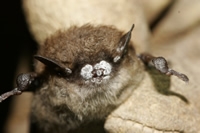
This disease is caused by a fungus that grows most noticeably on a bat’s muzzle, coating it in a white powder, hence the name "white-nose." It primarily affects hibernating bats by causing them to be more active, according to Long.
"As a result they wake up more often during the winter, burn up fat reserves, and die of starvation," Long said. Where the disease is occurring, bats that were relatively common are now rare.
"Like a tsunami on a quiet beach, white-nose syndrome is expected to strike California in the next couple of years," Long said. "With 25 species of bats in our state, the potential loss in the abundance and diversity of bats could be devastating."
Bats are extremely important in our environment. They are voracious predators of insects, often consuming their body weight in insects each night. As a result, they are important allies to farmers, helping to reduce the numbers of insects that damage crops and providing important ecosystem services in agricultural landscapes.
Currently no one knows where white-nose syndrome came from or how to control it. The disease first showed up in New York in 2006 in a cave that is a popular tourist destination, so it may have been introduced by a foreign visitor.
The hope is that enough bats have a strong enough immune system to survive the disease to repopulate the landscape before colonies go extinct. Likewise, researchers hope that the fungus will not adversely affect migratory colonies, that is, those bats that spend the winter in warmer climates and return to more temperate regions in spring and summer. The fungus favors cooler conditions so it may primarily impact bats that hibernate. California is home to both types of bats. For example, the Mexican freetailed bats migrate, but big brown bats hibernate.
Long suggests a number of ways that one can help bats and the white-nose syndrome crisis, including the following:
- Report unusual late-winter bat behavior (for example, bats flying during the daytime) or unexplained bat deaths to your state wildlife agency.
- Adhere to state, federal and local cave advisories and closures to help prevent the transmission of white-nose syndrome. Even though bats carry the fungus, people can also move the disease around and in greater distances than bats.
- Share with family and friends the benefits of bats and information about the white-nose syndrome crisis.
- Encourage state and federal legislators to allocate funding towards the effort to understand and fight white-nose syndrome.
For more information about bats, see Long's research articles published in California Agriculture journal: "Well-placed bat houses can attract bats to Central Valley farms" and "Bats feed on crop pests in Sacramento Valley."
The photo above of the little brown bat with white fungus on his nose is courtesy of Ryan von Linden of the New York Department of Environmental Conservation. The U.S. Fish and Wildlife Service has this photo and other photos showing symptoms and the effects of white-nose syndrome at http://www.fws.gov/WHITENOSESYNDROME/photos.html.